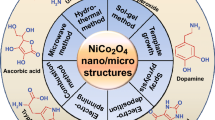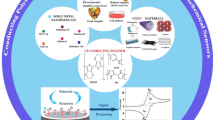Abstract
Nitrogen-doped carbon nanotubes (N-CNTs)/polyaniline (PANI) composites are developed as an electrode material for biosensors. The morphology, composition, and optical properties of the resulting products were characterized by transmission electron microscopy (TEM), thermogravimetric analysis (TGA), Fourier transform infrared spectroscopy (FT-IR), and ultraviolet-visible absorption spectra (UV-vis). Furthermore, N-CNTs/PANI composite was immobilized on the surface of a glassy carbon electrode (GCE) and applied to construct a sensor. The obtained N-CNTs/PANI-modified GCE showed one pair of redox peaks and high catalytic activity for the oxidation of dopamine (DA) in a neutral environment. Differential pulse voltammograms results illustrate that the fabricated DA biosensor has high anti-interference ability towards ascorbic acid (AA). In addition, the fabricated biosensor showed superior performances with two wide linear ranges from 1 to 80 μM and from 1.5 to 3.5 mM and a low detection limit of 0.01 μM.
Similar content being viewed by others
References
Chakraborty S, Raj CR. Amperometric biosensing of glutamate using carbon nanotube based electrode. Electrochem Commun, 2007, 9: 1323–1330
Gligor D, Varodi C, Muresan LM. Graphite electrode modified with a new phenothiazine derivative and with carbon nanotubes for NADH electrocatalytic oxidation. Chem Biochem Eng Q, 2010, 24: 159–166
Cui HF, Cui YH, Sun YL, Zhang K, Zhang WD. Enhancement of dopamine sensing by layer-by-layer assembly of PVI-dmeOs and nafion on carbon nanotubes. Nanotechnology, 2010, 21: 215601
Kumar SA, Chen SL, Chen SM. Electrochemical sensing of H2O2 at flavin adenine dinucleotide/chitosan/CNT nanocomposite modified electrode. Electrochem Solid-State Lett, 2010, 13: k83–k86
Cruz-Silva E, Cullen DA, Gu L, Romo-Herrera JM, Munoz-Sandoval E, Lopez-Urias F, Sumpter BG, Meunier V, Charlier JC, Smith DJ, Terrones H, Terrones M. Heterodoped nanotubes: Theory, synthesis, and characterization of phosphorus-nitrogen doped multiwalled car bon nanotubes. ACS nano, 2008, 2: 441–448
Lee SU, Belosludov RV, Mizuseki H, Kawazoe Y. Designing nanogadgetry for nanoelectronic devices with nitrogen-doped capped carbon nanotubes. Small, 2009, 5: 1769–1775
Xiong Y, Li Z, Guo Q, Xie Y. Synthesis of multi-walled and bamboo-like well-crystalline CNx nanotubes with controllable nitrogen concentration (x = 0.05–1.02). Inorg Chem, 2005, 44: 6506–6508
Tang YF, Allen BL, Kauffman DR, Star A. Electrocatalytic activity of nitrogen-doped carbon nanotube cups. J Am Chem Soc, 2009, 131: 13200–13201
Yang Y, Li X, Jiang J, Du H, Zhao L, Zhao Y. Control performance and biomembrane disturbance of carbon nanotube artificialWater channels by nitrogen-doping. ACS nano, 2010, 4: 5755–5762
Yano J, Kohno T, Kitani A. Electrochemical preparation of polyaniline microspheres incorporated with DNA. J Appl Electrochem, 2009, 39: 747–750
Jia P, Argun AA, Xu J, Xiong S, Ma J, Hammond PT, Lu X. Enhanced electrochromic switching in multilayer thin films of polyaniline-tethered silsesquioxane nanocage. Chem Mater, 2009, 21: 4434–4441
Gharibi H, Kakaei K, Zhiani M. Platinum nanoparticles supported by a vulcan XC-72 and PANI doped with trifluoromethane sulfonic acid substrate as a new electrocatalyst for direct methanol fuel cells. J Phys Chem C, 2010, 114: 5233–5240
Shao D, Hu J, Chen C, Sheng G, Ren X, Wang X. Polyaniline multiwalled carbon nanotube magnetic composite prepared byplasma-induced graft technique and its application for removal of aniline and phenol. J Phys Chem C, 2010, 114: 21524–21530
Tang Q, Wu J, Sun X, Li Q, Lin J. Shape and size control of oriented polyaniline microstructure by a self-assembly method. Langmuir, 2009, 25: 5253–5257
Mumtaz M, Labrugere C, Cloutet E, Cramail H. Synthesis of poly-aniline nano-objects using poly(vinyl alcohol)-, poly(ethylene oxide)-, and poly[(n-vinyl pyrrolidone)-co-(vinyl alcohol)]-based reactive stabilizers. Langmuir, 2009, 25: 13569–13580
Li L, Qin ZY, Xia X, Fan QQ, Lu YQ, Wu WH, Zhu MF. Facile fabrication of uniform core shell structured carbon nanotube-polyaniline nanocomposites. J Phys Chem C, 2009, 113: 5502–5507
Guo L, Peng Z. One-pot synthesis of carbon nanotube-polyaniline-gold nanoparticle and carbon nanotube-gold nanoparticle composites by using aromatic amine chemistry. Langmuir, 2008, 24: 8971–8975
Komathi S, Gopalan AI, Lee KP. Covalently linked silica-multiwall carbon nanotube-polyaniline network: An electroactive matrix for ultrasensitive biosensor. Biosens Bioelectron, 2009, 25: 944–947
Yue B, Ma YW, Tao HS, Yu LS, Jian GQ, Wang XZ, Wang XS, Lu YN, Hu Z. CNx nanotubes as catalyst support to immobilize platinum nanoparticles for methanol oxidation. J Mater Chem, 2008, 18: 1747–1750
Bhadra S, Singha NK, Khastgir D. Electrochemical synthesis of polyaniline and its comparison with chemically synthesized polyaniline. J Appl Polym Sci, 2007, 104: 1900–1904
Bhadra S, Singha NK, Khastgir D. Mechanical, dynamic mechanical, morphological, thermal behavior and processability of polyaniline and ethylene 1-octene based semi-conducting composites. J Appl Polym Sci, 2008, 107: 2486–2493
Bhadra S, Singha NK, Chattopadhyay S, Khastgir D. Effect of different Reaction parameters on the conductivity and dielectric properties of polyaniline synthesized electrochemically and modeling of conductivity against reaction parameters through regression analysis. J Polym Sci, Part B: Polym Phys, 2007, 45: 2046–2059
Salvatierra RV, Oliveira MM, Zarbin AJG. One-pot synthesis and processing of transparent, conducting, and freestanding carbon nanotubes/polyaniline composite films. Chem Mater, 2010, 22: 5222–5234
Wei D, Ivaska A. Electrochemical biosensors based on polyaniline. Chem Anal, 2006, 51: 839–852
Xu L, Zhu Y, Yang X, Li C. Amperometric biosensor based on carbon nanotubes coated with polyaniline/dendrimer-encapsulated Pt nanoparticles for glucose detection. Mater Sci Eng C, 2009, 29: 1306–1310
Wu X, Zhao B, Wu P, Zhang H, Cai C. Effects of ionic liquids on enzymatic catalysis of the glucose oxidase toward the oxidation of glucose. J Phys Chem B, 2009, 113: 13365–13373
Chen D, Wang Q, Jin J, Wu P, Wang H, Yu S, Zhang H, Cai C. Low-potential detection of endogenous and physiological uric acid at uricase-thionine single-walled carbon nanotube modified electrodes. Anal Chem, 2010, 82: 2448–2455
Ding H, Long Y, Shen J, Wan M. Fe2(SO4)3 as a binary oxidant and dopant to thin polyaniline nanowires with high conductivity. J Phys Chem B, 2010, 114: 115–119
Yan W, Feng X, Chen X, Li X, Zhu JJ. A selective dopamine biosensor based on AgCl@polyaniline core-shell nanocomposites. Bioelectrochem, 2008, 72: 21–27
Liu J, Tian S, Knoll W. Properties of polyaniline/carbon nanotube multilayer films in neutral solution and their application for stable low-potential detection of reduced β-nicotinamide adenine dinucleotide. Langmuir, 2005, 21: 5596–5599
Liu Y, Feng X, Shen J, Zhu JJ, Hou W. Fabrication of a novel glucose biosensor based on a highly electroactive polystyrene/polyaniline/Au nanocomposite. J Phys Chem B, 2008, 112: 9237–9242
Makos MA, Kim YC, Han KA, Heien ML, Ewing AG. In vivo electrochemical measurements of exogenously applied dopamine in drosophila melanogaster. Anal Chem, 2009, 81: 1848–1854
Kan X, Zhao Y, Geng Z, Wang Z, Zhu JJ. Composites of multiwalled carbon nanotubes and molecularly imprinted polymers for dopamine recognition. J Phys Chem C, 2008, 112: 4849–4854
Beni V, Ghita M, Arrigan DWM. Cyclic and pulse voltammetric study of dopamine at the interface between two immiscible electrolyte solutions. Biosens Bioelectron, 2005, 20: 2097–2103
Feng XM, Mao CJ, Yang G, Hou WH, Zhu JJ. Polyaniline/Au composite hollow spheres: synthesis, characterization, and application to the detection of dopamine. Langmuir, 2006, 22: 4384–4389
Author information
Authors and Affiliations
Corresponding authors
Additional information
These authors contributed equally to this work.
Rights and permissions
About this article
Cite this article
Feng, X., Li, R., Ma, Y. et al. Nitrogen-doped carbon nanotube/polyaniline composite: Synthesis, characterization, and its application to the detection of dopamine. Sci. China Chem. 54, 1615–1621 (2011). https://doi.org/10.1007/s11426-011-4330-y
Received:
Accepted:
Published:
Issue Date:
DOI: https://doi.org/10.1007/s11426-011-4330-y




